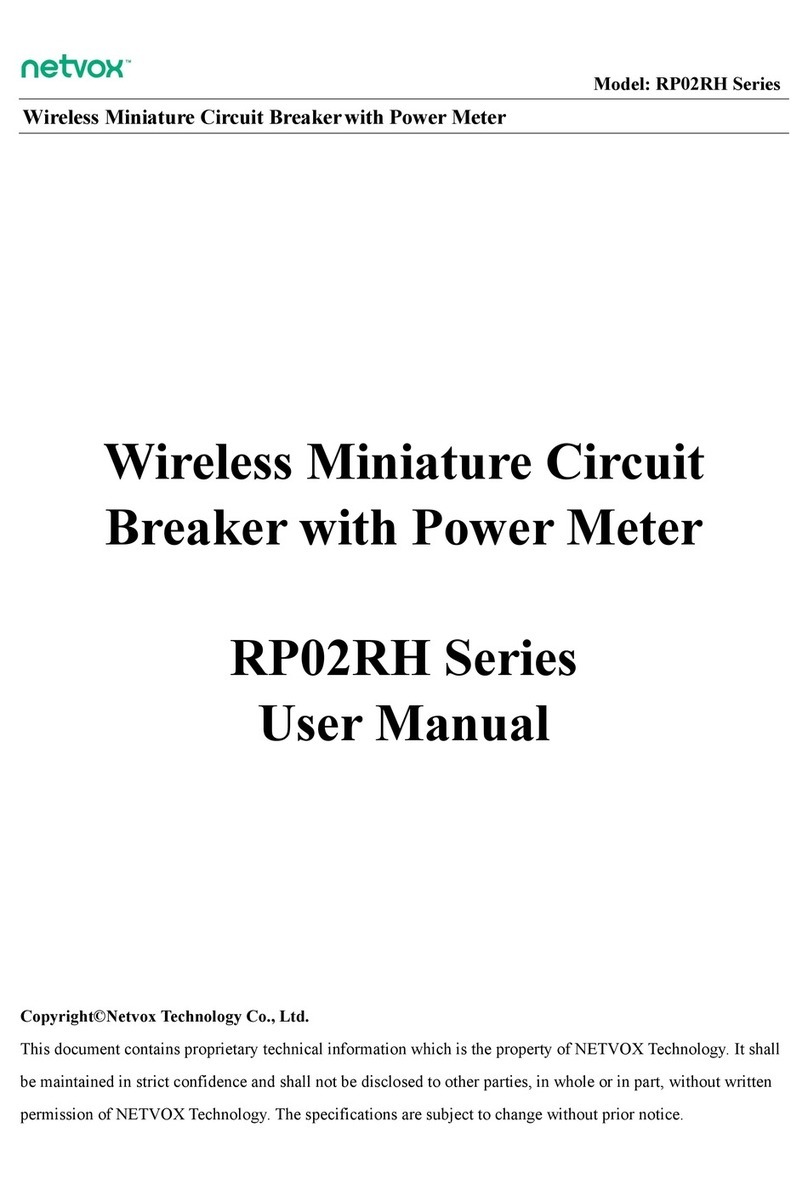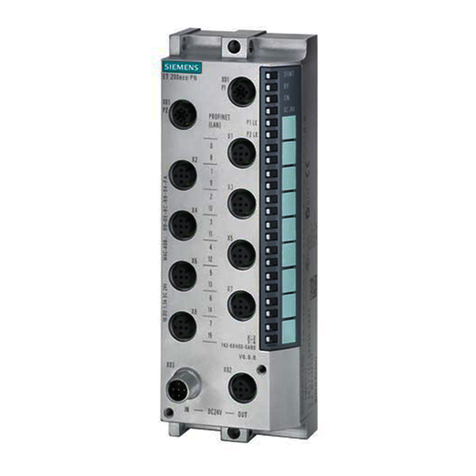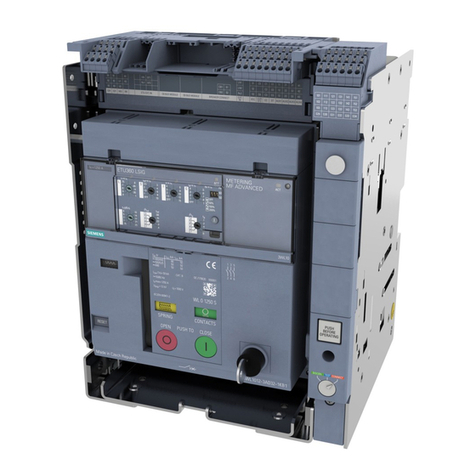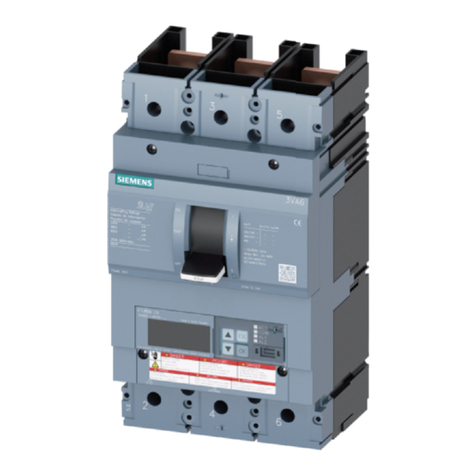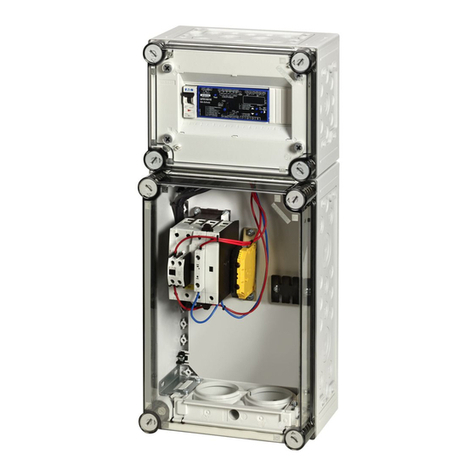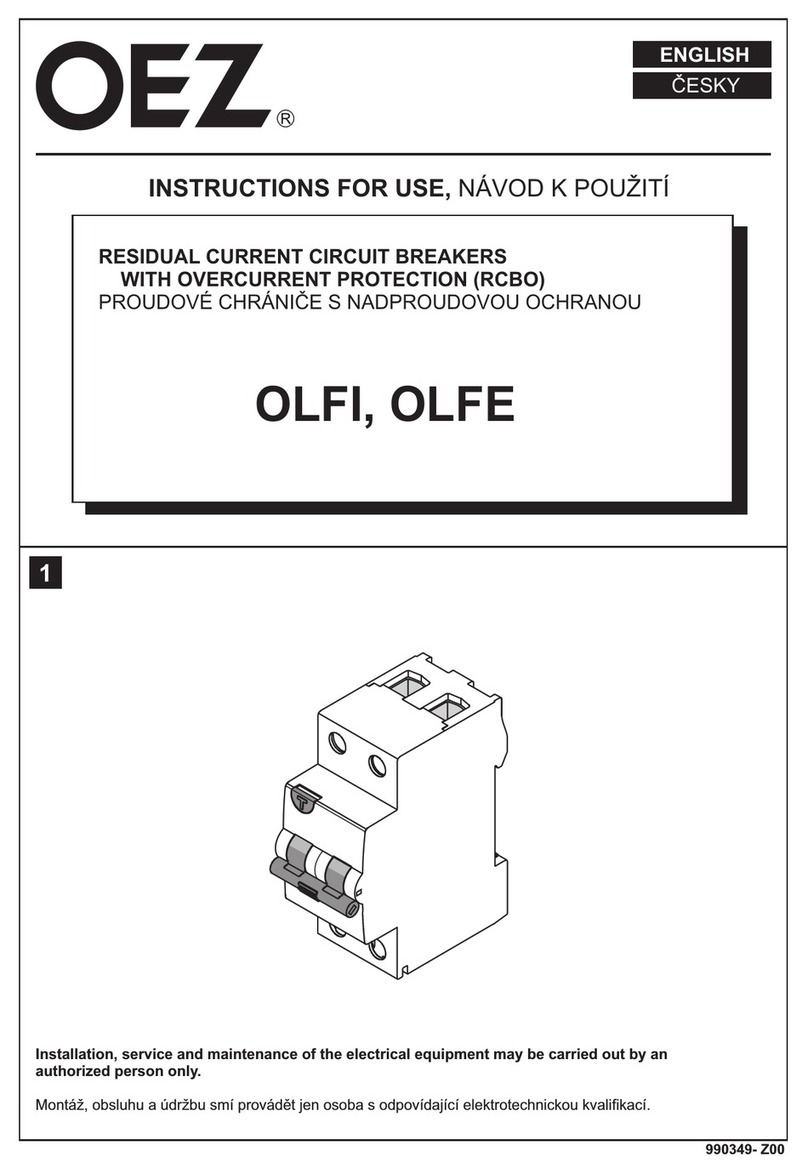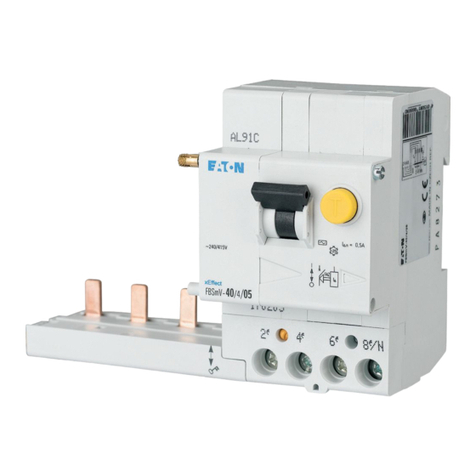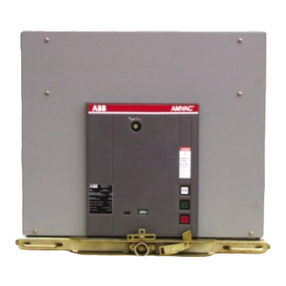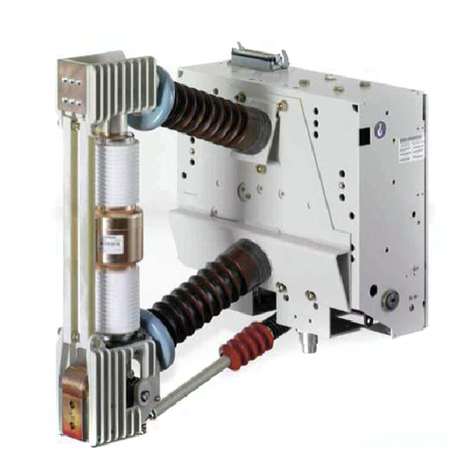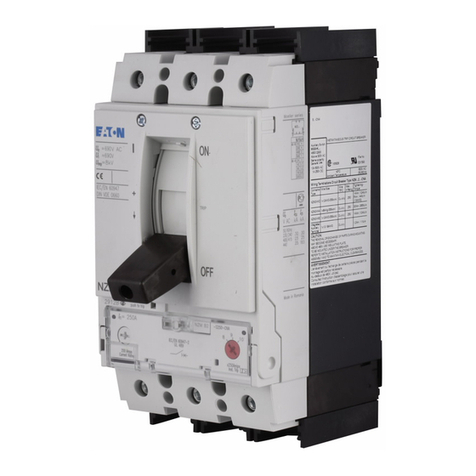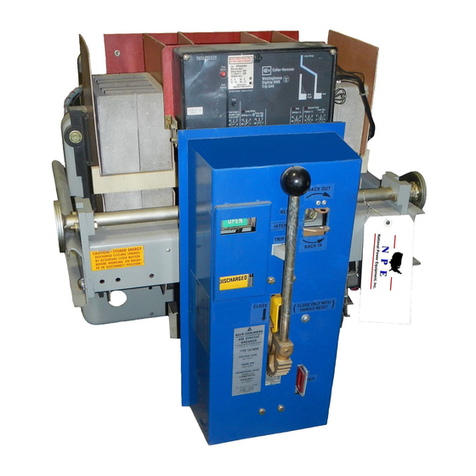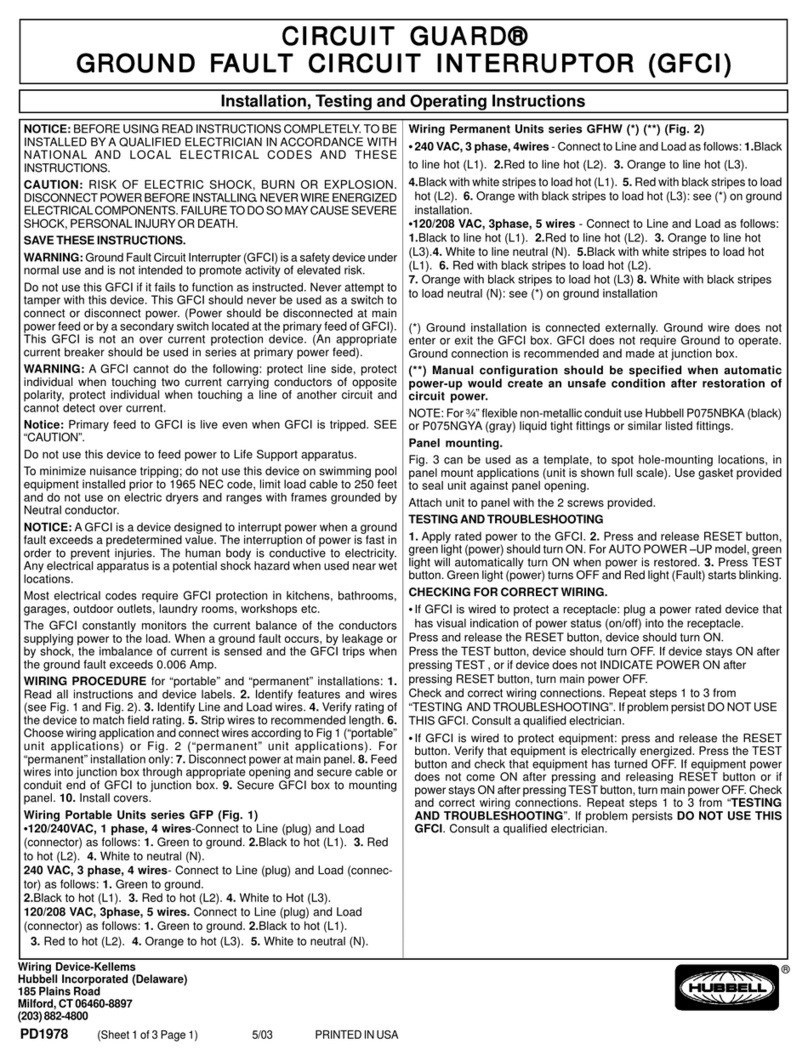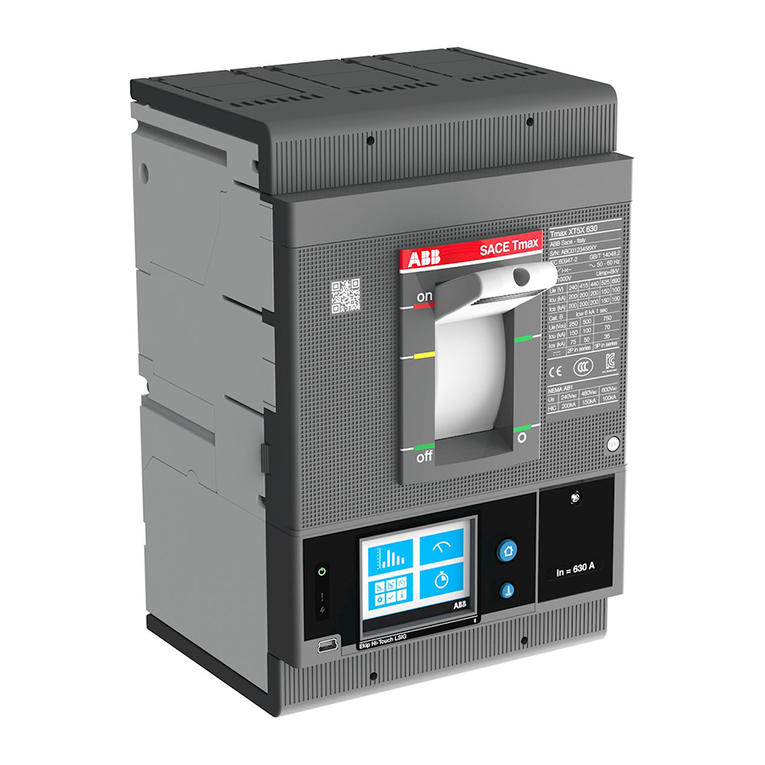netvox RP02RH Series User manual

Wireless Miniature Circuit Breaker
with Power Meter
RP02RH Series
User Manual
Copyright©Netvox Technology Co., Ltd.
This document contains proprietary technical information which is the property of NETVOX Technology. It shall be
maintained in strict confidence and shall not be disclosed to other parties, in whole or in part, without written permission
of NETVOX Technology. The specifications are subject to change without prior notice.
Wireless Miniature Circuit Breaker with Power Meter
RP02RH Series

1
Table of Contents
1. Introduction .......................................................................................................................................................................2
2. Appearance ........................................................................................................................................................................3
3. Features..............................................................................................................................................................................4
4. Set up Instruction...............................................................................................................................................................4
5. Data Report........................................................................................................................................................................5
5.1 Default Value of Protection Parameters.....................................................................................................................6
5.2 Example of ReportDataCmd......................................................................................................................................7
5.2.1 1PN/1PNL Report Data .....................................................................................................................................8
5.2.2 3PN/3PNL Report Data ...................................................................................................................................10
5.3 Example of ConfigureCmd by Acquisition Mode ...................................................................................................14
5.3.1 Report Configuration .......................................................................................................................................14
5.3.2 Remote Control Circuit Breaker......................................................................................................................15
5.3.3 Mode Switching...............................................................................................................................................16
5.4 Example of Configurecmd By Transparent Transmission Mode ............................................................................17
6. Applications .....................................................................................................................................................................18
7. Installation .......................................................................................................................................................................21
7.1 Circuit Breaker Installation......................................................................................................................................21
7.2 Wiring.......................................................................................................................................................................27
7.3 Dial Switch...............................................................................................................................................................28
7.4 Manual/ Automatic Self Inspection Function (For 1PNL, 3PNL) ..........................................................................28
7.5 Combination of Power Modules and Circuit Breakers............................................................................................29
8. Important Maintenance Instruction .................................................................................................................................31

2
1. Introduction
RP02RH1PN063 Wireless 1P+N Miniature Circuit Breaker with Power Meter
RP02RH1PNLB063 Wireless 1P+N Miniature Circuit Breaker with Power Meter and Leak Detection
RP02RH3PN063 Wireless 3P+N Miniature Circuit Breaker with Power Meter
RP02RH3PNLB063 Wireless 3P+N Miniature Circuit Breaker with Power Meter and Leak Detection
RP02RH2P100 Wireless 2P Miniature Circuit Breaker with Power Meter, 100A
RP02RH4P100 Wireless 4P Miniature Circuit Breaker with Power Meter, 100A
RP02RH3P250 Wireless 3P Miniature Circuit Breaker with Power Meter, 250A
RP02RH4P250 Wireless 4P Miniature Circuit Breaker with Power Meter, 250A
RP02RH series is a class C smart Miniature Circuit Breaker with Power Meter based on LoRaWAN open protocol. It can monitor
the status of all external circuit breakers in real time. (connect up to 9 poles). When the power line is abnormal (such as undervoltage,
overvoltage, overload, leakage, etc.), the system will automatically give early warning, alarm and power off to prevent electrical fire
to the greatest extent. At the same time, it can periodically monitor the temperature, electric quantity, current, voltage, power, leakage
current, circuit breaker status and other data information of all external circuit breakers and report to the gateway platform. With the
system, it can be controlled remotely and regularly, can be switched regularly, and can automatically conduct monthly leakage self-
inspection, with limited power and electric quantity. It has the function of local self-inspection and reports the detection information to
the gateway platform to make the hidden danger disappear.
At the same time, it can be switched to serial port transparent transmission mode, and can reply 128 bytes of data at most
(depending on the current communication rate). Serial port transparent transmission only supports RS-485 protocol.
The number of poles corresponding to each circuit breaker type:
Circuit Breaker Type
Number of Poles
1PN / 1PNL
2
3PN / 3PNL
4
LoRa Wireless Technology:
LoRa is a wireless communication technology famous for its long-distance transmission and low power consumption. Compared
with other communication methods, LoRa spread spectrum modulation technique greatly extend the communication distance. It can
be widely used in any use case that requires long-distance and low-data wireless communications. For example, automatic meter
reading, building automation device, wireless security systems, industrial monitoring. It has features like small size, low power
consumption, long transmission distance, strong anti-interference ability and so on.
LoRaWAN:
LoRaWAN uses LoRa technology to define end-to-end standard specifications to ensure interoperability between devices and
gateways from different manufacturers.
For example, a LoRa / LoRaWAN Radio Module can connect to:
(a) 4 * 1PN/1PNL (8 poles in total)
(b) 2 * 3PN/3PNL (8 poles in total)
(c) 2 * 1PN/1PNL + 1 * 3PN/3PNL (8 poles in total)

3
2. Appearance
LoRa/LoRaWAN Radio Module
RS-485 Interface
Indicator
Function Key
Antenna
Power Module
External Circuit Breaker
LoRa/LoRaWAN Radio Module
+
+
485 Signal Line
RP02RH1PN063

4
3. Features
⚫Compatible with LoRaWANTM
⚫Support RS485 serial port transparent transmission.
⚫Circuit breaker attribute value collection.
⚫Multiple circuit breaker protection.
⚫Simple operation and setting.
4. Set up Instruction
On/Restore to factory setting
Power on
Power supply of power module
Turn on
Power supply of power module. The green light flashes once: Success
Turn off (Restore to factory setting)
Press and hold the function key for 5 seconds until green indicator flashes for 20 times.
Power off
Disconnect the DC12V power supply
Note:
1. 5 seconds after power on, the device will be in engineering test mode.
2. The interval between two power outages and power on shall be about 10 seconds to
avoid the interference of energy storage elements such as capacities and inductors.
Network Joining
Never joined the network
Turn on the device to search the network.
The green indicator stays on for 5 seconds: Success
The green indicator remains off: Fail
Had joined the network
(Not restore to factory setting)
Turn on the device to search the previous network.
The green indicator stays on for 5 seconds: Success
The green indicator remains off: Fail
Fail to join the network
When the network cannot be added, it is recommended to check the device registration
information on the gateway or consult your platform server provider.
Function Key
Press and hold for 5 seconds
Restore to factory setting
The green indicator flashes for 20 times: Success
The green indicator remains off: Fail
Press once
The device is in the network: green indicator flashes once and sends a report
Rreport format: 87 + ReceiveData (ReceiveData is the latest received data)
The device is not in the network: green indicator remains off

5
Baud Rate Configuration
Default Baud Rate
9600
Collocation Method
Issue command through LoRaWAN
Baud Rate Options
00 Baudrate = 115200
01 Baudrate = 57600
02 Baudrate = 38400
03 Baudrate = 28800
04 Baudrate = 19200
05 Baudrate = 9600
06 Baudrate = 4800
07 Baudrate = 2400
5. Data Report
When the device is powered on, it will immediately send a version package report.
Default setting:
1. Acquisition Mode
ReportMaxTime: 0x0384 (900s) // Subject to factory settings
ReportMinTime: 0x000A (10s) // Netvox LoRa private default is 30s
2. Serial Port Transparent Transmission Mode
(1) The device has no operation before any configuration.
(2) The device sends instructions through LoRaWAN to configure the data to be sent through RS485, and reports the data
received by RS485 to the gateway at the same time.
(3) The device sends instructions through LoRaWAN to configure the time of sending the data periodically.
When the RS485 interface of LoRa/LoRaWAN Radio Module receives the serial port data sent by the RS485 device connected
with it, it will actively report the received data to the gateway in the format of 87 + Receive Data.
Note:
(1) The data transmission cycle of the device shall be subject to the burning configuration.
(2) Please refer Netvox LoRaWAN Application Command document and Netvox Lora Command Resolver
http://cmddoc.netvoxcloud.com/cmddoc to resolve uplink data.

6
5.1 Default Value of Protection Parameters
Protection Method:
RP02 Default Value of Protection Parameters
Protection
(Command)
Circuit
Breaker
Type
Hardware
Protection
Software
Protection
Alarm
Parameter
Default
Configuration
(through
LoRaWan
commands)
Alarm
Value
Action
Value
Time
Coefficient
0 - None
1-Alarm
2-Trip
3–Alarm and
Trip
Overload
Protection
(0x00)
MCB
●
●
113% Ir
125% Ir
(1PN, 1PNL)
120% Ir
(3PN, 3PNL)
15s
2 - Trip
●
MCCB
●
●
80% Ir
Ir
(Ir=250A)
12s
3 – Alarm and
Trip
Under Low-
voltage
Protection
(0x01)
MCB
●
●
180 V
160 V
3s
2 - Trip
●
MCCB
●
●
180V
(3P: 310V)
165V
(3P: 285V)
10s
0 - None
Overvoltage
Protection
(0x02)
MCB
●
●
260 V
270 V
6s
2 - Trip
●
MCCB
●
●
260V
(3P: 450V)
275V
(3P: 475V)
10s
0 - None
Leakage
Protection
(0x03)
MCB
●
-
30 mA
-
Trip
(cannot be
configured)
Hardware
Protection
cannot be
configured
MCCB
Temperature
Protection
(0x04)
MCB
●
●
75 ℃
80 ℃
30s
0 - None
●
MCCB
●
●
100℃
110℃
20s
1 - Alarm
Short Circuit
Protection
All
●
-
-
-
Trip
(cannot be
Hardware
Protection
0x00
None
0x01
Alarm
0x02
Trip
0x03
Alarm and trip

7
(0x05)
configured)
cannot be
configured
Phase Failure
Protection
(0x06)
(3PN, 3PNL
support)
All
●
●
70%
80%
10s
0 - None
●
Overpower
Protection
(0x07)
(1PN, 1PNL
support)
Smart
MCB
●
●
110% P
150%P
P = rated
voltage*
setting current
30s
0 - None
●
5.2 Example of ReportDataCmd
FPort:0x06
Bytes
1
1
1
Var(Fix=8 Bytes)
Version
DeviceType
ReportType
NetvoxPayLoadData
Version–1 byte –0x01——the Version of NetvoxLoRaWAN Application Command Version
DeviceType–1 byte –Device Type of Device
ReportType – 1 byte –the presentation of the NetvoxPayLoadData,according the DeviceType
NetvoxPayLoadData– Fixed bytes (Fixed =8bytes)
Tips
1. Battery Voltage:
If the battery is equal to 0x00, it means that the device is powered by a DC power supply.
2. Version Packet:
When Report Type=0x00 is the version packet, such as 01C9000A02202306210000, the firmware version is 2023.06.21.
3. Data Packet:
When Report Type=0x01 is data packet.
(If the device data exceeds 11 bytes or there are shared data packets, the Report Type will have different values.)
4. Signed Value:
When the temperature is negative, 2's complement should be calculated.
Note: (1) MCB refers to miniature circuit breaker. (2) MCCB refers to molded-case circuit breaker.

8
5.2.1 1PN/1PNL Report Data
ReportType = 0x01 – 0x04
Device
Device
Type
Report
Type
NetvoxPayLoadData
RP02RH
Series
0xC9
0x00
SoftwareVersion
(1Byte) Eg.0x0A—V1.0
HardwareVersion
(1Byte)
DateCode
(4Bytes,eg 0x20170503)
Reserved(2Bytes,fixed
0x00)
0x01
Breaker
RS485Addr
(1Byte)
BreakerType
(1Byte)
1:1P
2:1PN
3:1PNL
4:3P
5:3PN
6:3PNL
16:4P
BreakerProtect
StatusBits
(1Byte)
Bit0:Alarm,
Bit1:Pre-Trip
Bit2:Trip
Bit3-Bit7:
Reserved
AlarmStatusBits
(1Byte)
Bit0:OverLoad
Bit1:Reserved
Bit2:CreepAge
Bit3:UnderVol
Bit4:OverVol
Bit5:Temperature
Bit6:Other
Bit7:OverPower
Pre-TripStatusBits
(1Byte)
Bit0:OverLoad
Bit1: Other
Bit2:CreepAge
Bit3:UnderVol
Bit4:OverVol
Bit5:Temperature
Bit6:Other
Bit7:OverPower
TripStatusBits
(1Byte)
Bit0:OverLoad
Bit1: Other
Bit2:CreepAge
Bit3:UnderVol
Bit4:OverVol
Bit5: HighOverVo
Bit6: Temperature
Bit7: Other
HandOrAuto
ControlAnd
SelfTestStaus
(1Byte)
0x00_Auto
0x01_Hand
0x03_RemoteSelf
Test
OnOffStatus
(1Byte)
0x00_Off
0x01_On
0x02
BreakerRS485Addr
(1Byte)
Current
(2Bytes,Unit:10mA)
Voltage
(2Bytes,Unit:1V)
Power
(2Bytes,Unit:1w)
Temperature
(1Byte) Signed,
Unit:1°C
0x03
BreakerRS485Addr
(1Byte)
Energy
(4Bytes, unit:1wh)
Frequency
(1Byte,Unit:1HZ)
PowerFactor
(1Byte,Range:0-100)
Reserved
(1Byte,fixed 0x00)
0x04
BreakerRS485Addr
(1Byte)
LeakageCurrent
(2Bytes,
Unit:0.01mA)
OnOffTotalCount
(4Bytes)
Reserved
(1Byte,fixed 0x00)
Example of 1PN / 1PNL
#Packet 1: 01C9010203010800000100
1st byte (01): Version
2nd byte (C9): DeviceType - RP02RH Series
3rd byte (01): ReportType
4th byte (02): Breaker RS485Addr-2
5th byte (03): Breaker Type-3: 1PNL
6th byte (01): BreakerProtectStatusBits-Alarm, 0x01=00000001 (bit 0=1)
7th byte (08): AlarmStatusBits-UnderVol (Low voltage alarm) , 0x08 = 00001000 (bit3=1)
8th byte (00): Pre-TripStatusBits-NULL
9th byte (00): TripStatusBits-NULL
10th byte (01): HandOrAutoControlAndSelfTestStaus-Hand
11th byte (00): OnOffStatus-Off

9
#Packet 2: 01C902020000009500001B
1st byte (01): Version
2nd byte (C9): DeviceType -RP02RH Series
3rd byte (02): ReportType
4th byte (02): Breaker RS485Addr-2
5th – 6th byte (0000): Current-0mA
7th – 8th byte (0095): Voltage-149V, 0095 (HEX) = 149 (DEC), 149* 1V = 149V
9th – 10th byte (0000): Power-0 w
11th byte (1B): Temperature-27℃, 1B (HEX) = 27 (DEC), 27* 1℃ = 27℃
#Packet 3: 01C9030200000038310000
1st byte (01): Version
2nd byte (C9): DeviceType - RP02RH Series
3rd byte (03): ReportType
4th byte (02): Breaker RS485Addr-2
5th -8th byte (00000038): Energy-56wh, 00000038 (HEX) = 56 (DEC), 56* 1wh = 56wh
9th byte (31): Frequency-49 Hz, 31 (HEX) = 49 (DEC), 49* 1HZ = 49HZ
10th byte (00): PowerFactor-0
11th byte (00): Reserved
#Packet 4: 01C9040200000000007100
1st byte (01): Version
2nd byte (C9): DeviceType - RP02RH Series
3rd byte (04): ReportType
4th byte (02): Breaker RS485Addr-2
5th 6th byte (0000): LeakageCurrent-0
7-10th byte (00000071): OnOffTotalCount-113, 71 (HEX) = 113 (DEC)
11th byte (00): Reserved

10
5.2.2 3PN/3PNL Report Data
Report Type=0x11-0x18
Device
Device
Type
Report
Type
NetvoxPayLoadData
RP02H
Series
0xC9
0x11
BreakerRS485Addr
(1Byte)
BreakerType
(1Byte)
1:1P
2:1PN
3:1PNL
4:3P
5:3PN
6:3PNL
16:4P
BreakerProtectStatusBit
(2Bytes)
Bit0:Alarm
Bit1:Pre-Trip
Bit2:Trip
Bit3:OffLine
Bit4-Bit15: Reserved
AlarmStatusBit
(2Bytes)
Bit0:APhaseOverLoad
Bit1:BPhaseOverLoad
Bit2:CPhaseOverLoad
Bit3:NPhaseOverLoad
Bit4-5:Reserved
Bit6: CreepAge
Bit7:APhaseUnderVol
Bit8:BPhaseUnderVol
Bit9:CPhaseUnderVol
Bit10:APhaseOverVol
Bit11:BPhaseOverVol
Bit12:CPhaseOverVol
Bit13:Temperature
Bit14:Reserved
Bit15:LeakingPhase
Pre-TripStatusBits
(2Bytes)
Bit0:APhaseOverLoad
Bit1:BPhaseOverLoad
Bit2:CPhaseOverLoad
Bit3:NPhaseOverLoad
Bit4-5:Reserved
Bit6: CreepAge
Bit7:APhaseUnderVol
Bit8:BPhaseUnderVol
Bit9:CPhaseUnderVol
Bit10:APhaseOverVol
Bit11:BPhaseOverVol
Bit12:CPhaseOverVol
Bit13:Temperature
Bit14:Reserved
Bit15:LeakingPhase
0x12
BreakerRS485Addr
(1Byte)
TripStatusBits (2Bytes)
Bit0:A/NPhaseOverLoad
Bit1:BPhaseOverLoad
Bit2:CPhaseOverLoad
Bit3:APhaseInstantTrip
Bit4:BPhaseInstantTrip
Bit5:CPhaseInstantTrip
Bit6: CreepAge
Bit7:APhaseUnderVol
Bit8:BPhaseUnderVol
Bit9:CPhaseUnderVol
Bit10:APhaseOverVol
Bit11:BPhaseOverVol
Bit12:CPhaseOverVol
Bit13:Temperature
Bit14:RemoteSelfTest
Bit15:LeakingPhase
APhaseCurrent
(2Bytes,Unit:10mA)
BPhaseCurrent
(2Bytes,Unit:10mA)
Reserved
(1Byte,fixed 0x00)
0x13
BreakerRS485Addr
(1Byte)
CPhaseCurrent
(2Bytes,Unit:10mA)
APhaseVoltage
(2Bytes,Unit:1V)
BPhaseVoltage
(2Bytes,Unit:1V)
Temperature
(1Byte Signed,Unit:1°C)
0x14
BreakerRS485Addr
(1Byte)
CPhaseVoltage
(2Bytes,Unit:1V)
APhasePower
(2Bytes,Unit:1w)
BPhasePower
(2Bytes,Unit:1w)
Frequency
(1Byte,Unit:1HZ)
0x15
BreakerRS485Addr
(1Byte)
CPhasePower
(2Bytes,Unit:1w)
APhaseEnergy
(4Bytes, unit:1wh)
Reserved
(1Byte,fixed 0x00)
0x16
BreakerRS485Addr
(1Byte)
BPhaseEnergy
(4Bytes, unit:1wh)
APhasePowerFactor
(1Byte,Range:0-100)
BPhasePowerFactor
(1Byte,Range:0-100)
CPhasePowerFactor
(1Byte,Range:0-100)
0x17
BreakerRS485Addr
(1Byte)
CPhaseEnergy
(4Bytes, unit:1wh)
HandOrAuto
ControlStaus (1Byte)
0x00_Auto 0x01_Hand
OnOffStatus (1Byte)
0x00_Off 0x01_On
Reserved
(1Byte,fixed 0x00)
0x18
BreakerRS485Addr
(1Byte)
LeakageCurrent
(2Bytes,Unit:0.01mA)
OnOffTotalCount
(4Bytes)
Reserved
(1Byte,fixed 0x00)
Note: Please refer to the above NetvoxPayLoadData description for the specific reported data. If no related alarm is set, all alarm related
information bits are set to 0.

11
#Packet 1: 01C9110105000103800000
1st byte (01): Version
2nd byte (C9): DeviceType
3rd byte (11): ReportType
4th byte (01): BreakerRS485Addr –Alarm
5th byte (05): BreakerType–3PN
6th – 7th byte (0001): BreakerProtectStatusBits(3P)
8th – 9th byte (0380): AlarmStatusBits(3P) —UnderVol (Low voltage alarm), 896 (DEC) = 0011 1000 0000 (BIN) bit7–bit9=1
10th – 11th byte (0000): Pre-TripStatusBits(3P)
#Packet 2:01C9120100000000000000
1st (01): Version
2nd (C9): DeviceType
3rd (12): ReportType
4th (01): BreakerRS485Addr
5th – 6th (0000): TripStatusBits(3P)
7th – 8th (0000): APhaseCurrent – 0mA
9th – 10th (0000): BPhaseCurren – 0mA
11th (00): Reserved
#Packet 3:01C9130100000000000020
1st (01): Version
2nd (C9): DeviceType
3rd (13): ReportType
4th (01): BreakerRS485Addr
5th – 6th (0000): CPhaseCurrent – 0mA
7th – 8th (0000): APhaseVoltage – 0V
9th – 10th (0000): BPhaseVoltage – 0
11th (20): Temperature – 32℃ 20(HEX)=32(DEC),32*1℃=32℃

12
#Packet 4:01C9140100950000000032
1st (01): Version
2nd (C9): DeviceType
3rd (14): ReportType
4th (01): BreakerRS485Addr
5th – 6th (0095): CPhaseVoltage – 149V 0095 (HEX) = 149 (DEC), 149* 1V = 149V
7th – 8th (0000): APhasePower– 0W
9th – 10th (0000): BPhasePower – 0
11th (32): Frequency – 50HZ 32 (HEX) = 50 (DEC), 50* 1HZ = 50HZ
#Packet 5:01C9150100000000000000
1st (01): Version
2nd (C9): DeviceType
3rd (15): ReportType
4th (01): BreakerRS485Addr
5th – 6th (0000): CPhaseVoltage – 149V 0095 (HEX) = 149 (DEC), 149* 1V = 149V
7th – 10th (00000000): APhaseEnergy–0wh
11th (00): Reserved
#Packet 6:01C9160100000000000000
1st (01): Version
2nd (C9): DeviceType
3rd (16): ReportType
4th (01): BreakerRS485Addr
5th – 8th (00000000): BPhaseEnergy –0w
9th (00): APhasePowerFactor
10th (00): BPhasePowerFactor
11th (00): CPhasePowerFactor

13
#Packet 7:01C917010000000C010000
1st (01): Version
2nd (C9): DeviceType
3rd (17): ReportType
4th (01): BreakerRS485Addr
5th – 8th (0000000C): CPhaseEnergy –12wh 0000000C (HEX) = 12 (DEC), 12* 1wh = 12wh
9th (01): HandOrAutoControlStaus
10th (00): OnOffStatus –off
11th (00): Reserved
#Packet 8:01C91801FFFF000003D900
1st (01): Version
2nd (C9): DeviceType
3rd (18): ReportType
4th (01): BreakerRS485Addr
5th – 6th (FFFF): LeakageCurrent –FFFF(N/A)
7th–10th (000003D9): OnOffTotalCount –985 3D9 (HEX) = 985 (DEC)
11th (00): Reserved

14
5.3 Example of ConfigureCmd by Acquisition Mode
FPort:0x07
Bytes
1
1
Var (Fix =9 Bytes)
CmdID
DeviceType
NetvoxPayLoadData
CmdID–1 byte
DeviceType–1 byte –Device Type of Device
NetvoxPayLoadData– var bytes (Max=9bytes)
5.3.1 Report Configuration
Description
Device
Cmd
ID
Device
Type
NetvoxPayLoadData
Config
ReportReq
RP02RH
Series
0x01
0xC9
MinTime
(2bytes Unit:s)
MaxTime
(2bytes Unit:s)
Reserved
(5Bytes,Fixed 0x00)
Config
ReportRsp
0x81
Status
(0x00_success)
Reserved
(8Bytes,Fixed 0x00)
ReadConfig
ReportReq
0x02
Reserved
(9Bytes,Fixed 0x00)
ReadConfig
ReportRsp
0x82
MinTime
(2bytes Unit:s)
MaxTime
(2bytes Unit:s)
Reserved
(5Bytes,Fixed 0x00)
(1) Configure RP02RH Series parameters MinTime=10s (0x000A), MaxTime=3600s (0x0E10)
Downlink: 01C9000A0E100000000000
Device return: 81C9000000000000000000 (configuration successful)
81C9010000000000000000 (configuration failed)
(2) Read the RP02RH Series parameter
Downlink: 02C9000000000000000000
Device return: 82C9000A0E100000000000 (device current parameter)
Note:
(1) Number of report packet:
1PN/1PNL: 1PNreportcount = 4 (0x00–0x04); 3PN/3PNL: 3PNreportcount = 8 (0x01–0x18)
ReportMaxTime shall be configured based on the type and number of the connected circuit breaker.
(2) Example
When Two 1PN/1PNL and one 3PN/3PNL are connected to RP02RH series, …
(a) ReportMaxTime shall be greater than (2* 1PNreportcount + 1* 3PNreportcount)* MinTime
(b) MinTime ≥ 120 seconds when the frequency band is EU868.

15
5.3.2 Remote Control Circuit Breaker
Description
Device
CmdID
Device
Type
NetvoxPayLoadData
Off
RP02RH
Series
0x90
0xC9
BreakerRS485Addr
(1Byte)
Reserved
(8Bytes,Fixed 0x00)
On
0x91
BreakerRS485Addr
(1Byte)
Reserved
(8Bytes,Fixed 0x00)
ClearEnergy
0x93
BreakerRS485Addr
(1Byte)
Reserved
(8Bytes,Fixed 0x00)
LeakageCurrent
SeftTest
0x95
BreakerRS485Addr
(1Byte)
Reserved
(8Bytes,Fixed 0x00)
(1) Control address 1 circuit breaker off
Downlink: 90C9010000000000000000
(2) Control address 1 circuit braker on
Downlink: 91C9010000000000000000
(3) Clear the circuit breaker of address 1 and clear the electric energy
Downlink: 93C9010000000000000000
(4) Control address 1 circuit breaker leakage self-test (Note: does not support 250A MCCB )
Downlink: 95C9010000000000000000
SetProtection
Req
RP02RH
Series
0x05
0xC9
BreakerRS485Addr
(1Byte)
ProtectionType
(1Byte)
0x00_OverLoad
0x01_UnderVoltage
0x02_OverVoltage
0x04_Temperature
0x06_ LeakingPhase
0x07_OverPower
ProtectionAction
(1Byte)
0x00_None
0x01_Alarm
0x02_Trip
0x03_Alarm and Trip
Reserved
(6Bytes,
Fixed 0x00)
SetProtection
Rsp
0x85
Status(0x00_success)
Reserved (8Bytes,Fixed 0x00)
(1) Configure the BreakerRS485Addr = 0x01; ProtectionType = 0x04_Temperature; ProtectionAction = Alarm and Trip
Downlink: 05C9010403000000000000
Response: 85C9000000000000000000
Note: The rated current of the circuit breaker can be set as 6A /10A /16A /20A /25A /32A
/40A /50A /63A. The setting value could not exceed the supported value of hardware.
Please check CircuitBreakerConfigTool and its user manual for configuration and
detailed information.

16
5.3.3 Mode Switching
Description
Device
CmdID
Device
Type
NetvoxPayLoadData
SetPassThroughModeReq
RP02RH
Series
0x03
0xC9
PassThroughModeOn(1Byte)
0x00_Off
0x01_On
Reserved
(8Bytes,Fixed 0x00)
SetPassThroughModeRsp
0x83
Status
(0x00_success)
Reserved
(8Bytes,Fixed 0x00)
GetPassThroughModeReq
0x04
Reserved
(9Bytes,Fixed 0x00)
GetPassThroughModeRsp
0x84
PassThroughModeOn(1Byte)
0x00_Off
0x01_On
Reserved
(8Bytes,Fixed 0x00)
(1)The configuration mode is acquisition mode
Downlink: 03C900000000000000000
Device return: 83C9000000000000000000 (configuration successful)
83C9010000000000000000 (configuration failed)
(2)Get current device mode
Downlink: 04C900000000000000000
Device return:84C9000000000000000000 (acquisition mode)
84C9010000000000000000 (transparent transmission mode)

17
5.4 Example of Configurecmd By Transparent Transmission Mode
FPort:0x0A
Description
Device
CmdID
NetvoxPayLoadData
SetPollSensorRawCmdReq
RP02RH
Series
0x05
SensorRawCmd
SetPollSensorRawCmdRsp
0x85
Status
(0x00_success)
SensorRawCmdIndication
0x87
SensorRawCmd
(Var bytes,according sensor datasheet)
If the protocol format of the external RS485 device is, …
Transmission frame: 010400100002700E
Return frame: 01040440C5D2F2235C
(1) Configure device SensorRawCmd
Downlink: 0501040010000270E
Device return: 8500 (configuration succeed)
8501 (configuration fail)
(2) Report after 5 seconds: 8701040440C5D2F2235C

18
6. Applications
Smart Home
Problems:
⚫Unclear reason for the rise in electricity charges
⚫Unclear cause of electrical failure
⚫The waste of electric energy cannot be treated
⚫Electrical hazards cannot be eliminated in time
Solutions:
⚫Effective energy saving: Master the power consumption information at home, reduce unconscious waste and standby power
consumption
⚫Remote control: Close the loop remotely, realize the one key disconnection function, and limit the time and power
⚫Ensure safety: Realize multiple protection and self-inspection of protection function
⚫Strengthen prevention: Push line fault and remind users in time to ensure personal safety
School
Problems:
⚫Students use high-power electrical appliances in violation of regulations, which has great hidden dangers to cause fire
⚫Accidental contact of students and fire caused by electric leakage accident
⚫Complex power environment, high personnel destiny and poor strain capacity
⚫Serious waste of electric energy
Solutions:
⚫Safety protection: Set rated power, over limit alarm, limit malignant load and ensure power safely
⚫Remote control: Timing control, energy saving and consumption reduction, realizing people walking lights off and device power
off
⚫Fault energy warning: Power off and maintain the lines with electrical hazards in advance to prevent accidents
⚫Cost reduction: Students’ dormitories realize remote meter reading charges and reduce management costs
Intelligent Building
Problems:
⚫Complex power environment, high personnel density and poor strain capacity
⚫Serious waste of electric energy
⚫Personnel use high-power electrical appliances in violation of regulations, which has great hidden dangers to cause fire
⚫Accidental electric shock and electric leakage accident cause fire

19
Solutions:
⚫Safety protection: Set rated power, over limit alarm, limit malignant load and ensure power safety
⚫Remote control: Timing control, energy saving and consumption reduction, realizing people walking lights off and device power
off
⚫Fault early warning: Power off and maintain the lines with electrical hazards in advance to prevent accidents
⚫Cost reduction: The meter can realize remote meter reading and charging, and reduce the management cost
Public Places
Problems:
⚫Lack of effective power safely solutions
⚫Few professional managers and difficult management of many electric devices
⚫Poor safety awareness and failure to trouble shooting
⚫Electrical fire occurs frequently
Solutions:
⚫Fault analysis: Accurately analyze fault types and give solutions in time
⚫Intelligent supervision: Real-time online monitoring of fire hazards, like a 24-hour close doctor using electricity
⚫Remote control: Timely power-off protection shall be provided for the fault line to master the power safely
⚫Fire prevention: Comply with the national fire safety management for dense places
Fire protection and security
Problems:
⚫Traditional firefighting emphasizing fire elimination and neglecting prevention’’
⚫Electrical hazards cannot be eliminated in advance, causing major personal injury in case of fire
⚫Insufficient supervision investment and poor basic control ability
⚫Poor realization of fire protection design and no self-inspection function
Solutions:
⚫Eliminate potential fire hazards: Overload, short circuit, real time monitoring of electric leakage, over temperature and ignition
to eliminate the fire at the source
⚫Reduce fire: The system is based on real-time acquisition, regular self-inspection and data processing, realize intelligent electrical
fire early reduce the occurrence of electrical fire hazards
Other manuals for RP02RH Series
1
This manual suits for next models
8
Table of contents
Other netvox Circuit Breaker manuals
